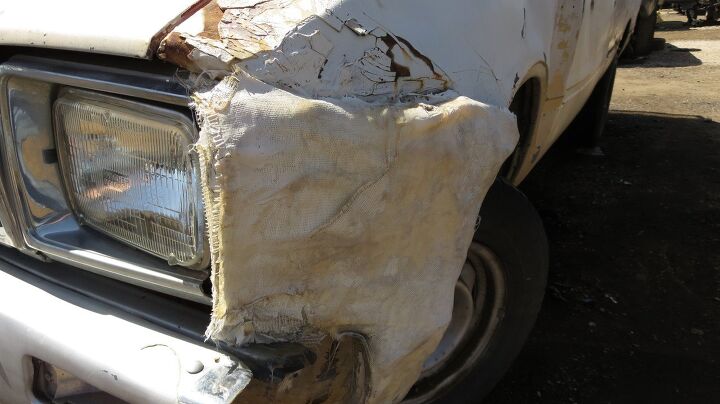Junkyard Find: 1983 Toyota Pickup, Adobe Rust Repair Edition

Toyotas of the 1970s and 1980s were quite reliable for the era, if you’re just talking about running gear. If you lived in a rust-prone area, though (say, a block from the Pacific Ocean in San Francisco), Toyotas were eaten by the Iron Oxide Monster in a hurry. Here in Denver, where the snow usually doesn’t stick around long enough to warrant the application of road salt and the single-digit humidity dries out pockets of moisture trapped behind body panels before they can cause much harm, you don’t see too many rust horror-shows in junkyards. However, being conveniently located to both the western edge of the Rust Belt and the salty-road mountains means that I do see some interesting approaches to the Rotting Toyota Problem. Here’s a camper-shell-equipped Missouri Hilux (sold as, simply, the “Toyota Truck” in the United States) with some fiberglass-and-body-filler bodywork that may have bought it another year or two on the road.
Actually, the shell came from Missouri; there’s no telling where the truck came from (though the shell appears to have been on the truck since it was new-ish).
Not even 200,000 miles on the clock.
Bondo over rust solves the problem in about the same way that painting over termite damage fixes your house.
I keep hearing that 20R heads are worth plenty to the guys who want to swap them onto their 22R off-road trucks and get higher compression, but I never see them removed at junkyards. Urban legend?
Mechanically speaking, this truck probably had a lot of life left in it, but watching shards of your vehicle tumbling behind you in the rear-view mirror while listening to the howl of wind through all the rust holes… well, it gets old.
There are parts of the world, however, where Hilux owners don’t worry about how rusty their trucks might be.
The Australians have always had better Hilux ads than North Americans.
See what I mean?

Murilee Martin is the pen name of Phil Greden, a writer who has lived in Minnesota, California, Georgia and (now) Colorado. He has toiled at copywriting, technical writing, junkmail writing, fiction writing and now automotive writing. He has owned many terrible vehicles and some good ones. He spends a great deal of time in self-service junkyards. These days, he writes for publications including Autoweek, Autoblog, Hagerty, The Truth About Cars and Capital One.
More by Murilee Martin
Latest Car Reviews
Read moreLatest Product Reviews
Read moreRecent Comments
- Kwik_Shift_Pro4X Canadians are able to win?
- Doc423 More over-priced, unreliable garbage from Mini Cooper/BMW.
- Tsarcasm Chevron Techron and Lubri-Moly Jectron are the only ones that have a lot of Polyether Amine (PEA) in them.
- Tassos OK Corey. I went and saw the photos again. Besides the fins, one thing I did not like on one of the models (I bet it was the 59) was the windshield, which looked bent (although I would bet its designer thought it was so cool at the time). Besides the too loud fins. The 58 was better.
- Spectator Lawfare in action, let’s see where this goes.





















































Comments
Join the conversation
I don't know why the snow belt switched from sand to salt and chemicals to keep roads passable. I remember as a kid in Massachusetts, seeing trucks with claws remove the sand from storm drain boxes, to filter and re-use. Only a motorist class-action lawsuit could stop cities from dumping tons of Bonneville Salt Flats, Utah onto their streets. Last year, Boston didn't know where to put all the snow since they weren't allowed to dump it in rivers and bays like the old days. The western Great Lakes had the same problem the year before. So where does the salt and chemicals go when the snow melts? Into storm drains that dump it in rivers and bays.
This brings back memories. I had a 1978 Toyota Truck that I bought after college in 2002, affectionally named "Ghetto Truck". The panels mismatched in color, he smelt badly, was loud, and was just crude. I had a longer commute and wanted to keep the miles off my then-newer Hyundai Elantra. The truck was owned by a co-worker of my Dad's and he had purchased it for his teenage daughter. She thought it was ugly and refused to drive it, and it sat for years on a property. For $300, we unloaded the truck off him. It needed a new carbuerator, but otherwise, everything worked fine considering the 210k miles on it. I loved that truck and it was full of character. It did smell like exhaust, which has probably taken years off my life, but who cares when you're 20? The truck bed would rattle like the dickens over any bumps with a loud metal-to-metal clunking sound. There was a towel between the battery and the metal hood to prevent a reinactment of 4th of July fireworks. There was absolutely zero sound insulation in the cabin and the metal steering wheel was awful to hold onto in the desert heat. I placed another 30k miles on the truck over the course of 3 1/2 years and have pictures of it in front of the Hollywood Sign and Golden Gate Bridge. Eventually, life changes and too many parts wearing out forced me to sell it for $800 (in running condition) to a neighbor kid. Last time I heard, the truck was in Mexico somewhere. I still look back fondly on that truck, and any Toyota pickup from this era.